You should be prepared for several plumbing emergencies that can disrupt your home. Burst pipes, often caused by freezing, can lead to extensive water damage. Clogged drains typically result from buildup and can become persistent without maintenance. Overflowing toilets may indicate blockages or faulty components. You might as well encounter leaky faucets, no hot water issues, sewer backups, and slab leaks. Understanding these emergencies and knowing how to respond can save you significant costs. To improve your preparedness, consider exploring effective solutions and preventative measures available.
Key Takeaways
- Burst Pipes can cause extensive water damage; knowing how to locate emergency valves is crucial for quick response.
- Clogged Drains can lead to severe plumbing issues; regular maintenance and DIY methods can help prevent blockages.
- Overflowing Toilets often result from clogs or faulty components; turning off the shut-off valve is the first step in managing the issue.
- No Hot Water can stem from electrical issues or sediment buildup; routine checks and maintenance are essential to avoid this problem.
- Emergency Contacts for reliable plumbers should be readily available, along with knowledge of shut-off valves to mitigate plumbing emergencies.
Burst Pipes
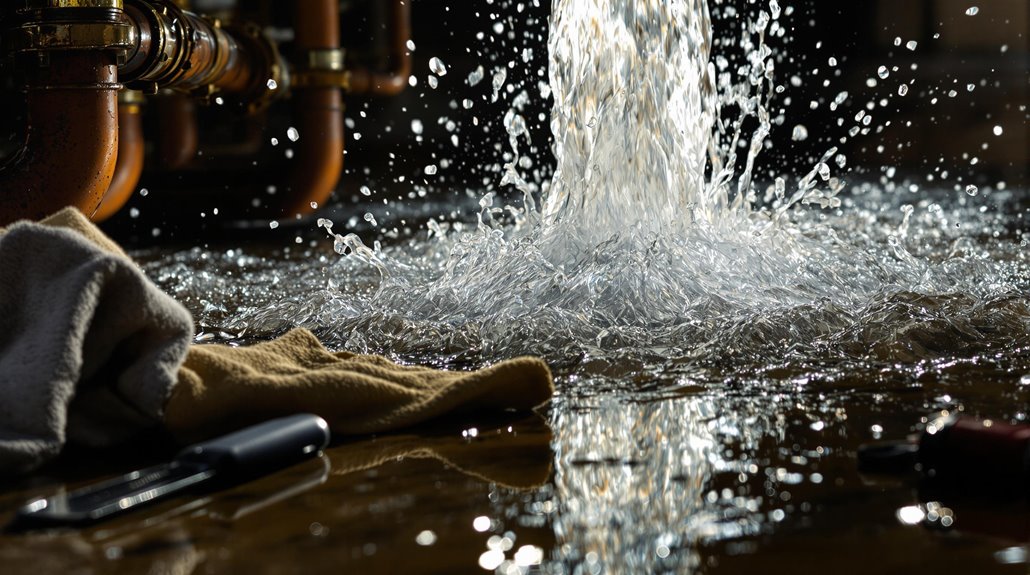
Burst pipes are one of the most common plumbing emergencies, often resulting in significant water damage if not addressed quickly. To prevent this issue, proper pipe insulation is crucial, especially in colder climates where temperatures can drop below freezing. Insulating your pipes helps maintain a consistent temperature, reducing the risk of freezing and bursting. Moreover, installing emergency valves can provide quick access to shut off water flow, minimizing damage when a pipe does burst. If you experience a burst pipe, locate your emergency valve immediately to stop the water. After that, call a professional plumber to assess the damage and guarantee proper repairs. Taking these preventive measures and knowing how to react can save you from costly repairs and extensive water damage. Additionally, 24/7 availability of emergency plumbing services ensures that help is always just a call away when you need it most.
Clogged Drains
When you notice water draining slowly or not at all, it's likely you're facing a clogged drain, a common yet frustrating plumbing issue. Regular drain maintenance is crucial to prevent buildup from hair, grease, and debris. You can often tackle minor clogs with some DIY unclogging techniques. Start with a plunger or a plumber's snake to dislodge blockages. For tougher clogs, try a mixture of baking soda and vinegar, followed by hot water. If these methods fail, you might need to contemplate professional help. Remember, neglecting clogged drains can lead to more severe plumbing problems, so stay proactive about your drain care to keep your plumbing system running smoothly. Additionally, seeking expert water damage restoration services can help prevent further damage if clogs lead to overflow issues.
Overflowing Toilets
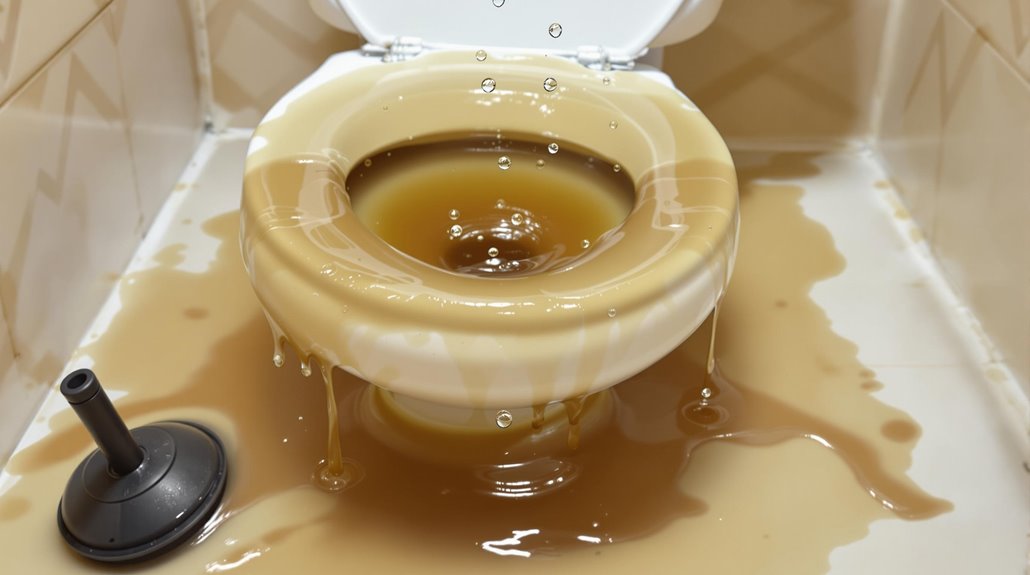
Overflowing toilets can stem from various issues, including clogs or faulty float mechanisms. When faced with this situation, it's vital to act quickly to minimize water damage. Understanding the causes and knowing immediate response steps can help you regain control and prevent further problems.
Causes of Overflowing Toilets
Toilets can overflow for several reasons, often stemming from blockages or mechanical failures. Understanding these causes can help you prevent flushing issues. Here are some common reasons your toilet might overflow:
- Clogged Drain: Foreign objects or excessive toilet paper can block the drain, causing water to back up.
- Faulty Flapper: A worn or damaged flapper in the toilet tank can lead to continuous water flow, overwhelming the bowl.
- Blocked Vent Pipe: A vent pipe obstruction can disrupt drainage and lead to overflow.
- Malfunctioning Float: If the float mechanism is stuck, it may allow too much water into the tank, causing it to spill.
Immediate Response Steps
Experiencing an overflowing toilet can be alarming, but knowing how to respond quickly can minimize damage and restore order. First, grab your emergency kit and locate the shut-off valve, usually found behind the toilet. Turn it clockwise to stop water flow immediately. Next, use a plunger to attempt to clear any blockages. If this doesn't work, you may need plumbing tools, such as a toilet auger, to tackle deeper clogs. Keep towels or rags handy to mop up any spills. Finally, inspect for any damage and consider calling a plumber if the issue persists. Acting fast and having the right tools on hand will help you manage the situation effectively.
Leaky Faucets
A persistent drip from a leaky faucet can be more than just an annoyance; it signals a potential issue that needs addressing. Ignoring it can lead to increased water bills and waste, undermining your water conservation efforts. To tackle faucet repairs effectively, consider these steps:
- Identify the type of faucet – Different models require specific repair methods.
- Turn off the water supply – Prevent further leaks by shutting off the faucet's water source.
- Disassemble the faucet – Carefully take it apart to access the internal components.
- Replace worn parts – Look for damaged washers or O-rings and swap them out.
No Hot Water
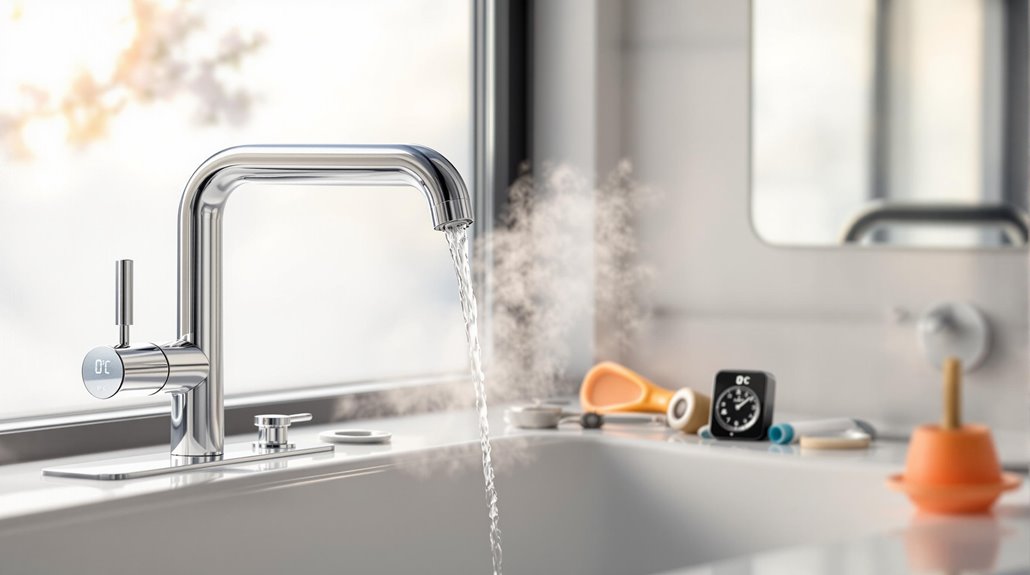
When you encounter no hot water, understanding the potential causes is crucial. Start with quick troubleshooting steps to identify whether the issue is minor or requires professional help. Knowing when to call in an expert can save you time and prevent further damage.
Causes of No Hot Water
If you've suddenly found yourself without hot water, several common causes may be at play. Understanding these can help you address the issue effectively:
- Electrical Issues: A tripped breaker or blown fuse could cut power to your water heater.
- Water Heater Maintenance: Neglecting regular maintenance can lead to sediment buildup, affecting performance.
- Thermostat Problems: A malfunctioning thermostat might cause temperature fluctuations, preventing the water from heating properly.
- Pilot Light Out: For gas heaters, a blown pilot light can stop hot water production entirely.
Quick Troubleshooting Steps
Experiencing a lack of hot water can be frustrating, but you can often troubleshoot the issue quickly. First, check your thermostat settings; verify they're set correctly and the power's on. If you have a tank water heater, inspect the circuit breaker for tripped switches. Use basic plumbing tools to test the heating elements or, in the case of a gas heater, check the pilot light. If you notice leaks or corrosion, that's a sign of a more severe problem. Keep emergency preparedness in mind by having necessary tools on hand, like a multimeter or wrench, for quick fixes. By following these steps, you can often resolve the situation without needing immediate professional assistance.
When to Call Professionals
How can you tell when it's time to call in the experts for your hot water issues? If you're facing no hot water, it's critical to know when to seek emergency plumbing help. Here are four signs that indicate you should reach out for professional services:
- Persistent Cold Water: You've tried troubleshooting, but the water remains cold.
- Strange Noises: Your water heater is making unusual sounds, signaling potential failure.
- Leaks or Puddles: You notice water pooling around your heater, indicating a leak.
- Temperature Fluctuations: The hot water temperature is inconsistent, causing discomfort.
If you experience any of these issues, don't hesitate to call professionals to prevent further damage and guarantee safety.
Sewer Backups
When faced with a sewer backup, understanding its causes can help you respond effectively. Common culprits include tree root intrusion, grease build-up, and damaged pipes. If you notice a sewage odor in your home, it's a clear sign that something's wrong. Start with a sewer inspection to identify the problem area. This process involves using a camera to get a clear view of the pipes and locate blockages. Depending on the issue, you may need to clear the clog or repair damaged sections. Regular maintenance, such as avoiding flushing non-biodegradable items, can help prevent future backups. Be proactive in addressing issues to guarantee your plumbing system runs smoothly and efficiently.
Water Heater Issues
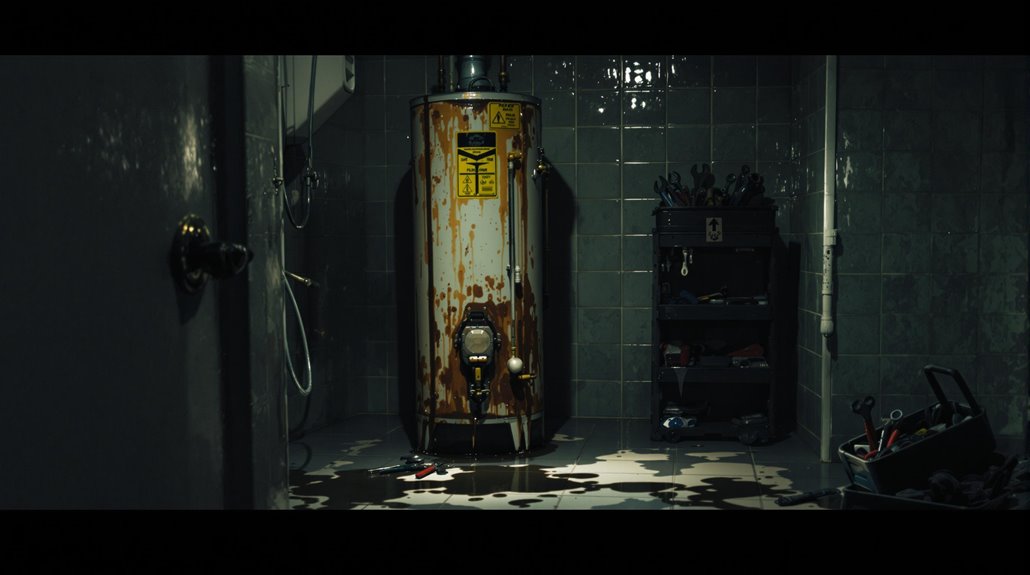
Sewer backups aren't the sole plumbing emergencies that can disrupt your home; water heater issues can likewise cause significant inconvenience. Whether you have a traditional tank or are considering tankless options, knowing the common problems can save you from unexpected cold showers. Here are four key water heater issues to watch for:
- No Hot Water: Often caused by a faulty thermostat or heating element.
- Leaking Tank: Check for corrosion or loose connections.
- Strange Noises: Sediment buildup can lead to rumbling sounds.
- Water Discoloration: Rusty water may indicate tank deterioration.
Regular water heater maintenance can help prevent these issues and keep your system running efficiently. Stay proactive and consider upgrading to a tankless option for on-demand hot water.
Slab Leaks
Although slab leaks can be elusive, they can cause serious damage to your home if not addressed promptly. These leaks occur in a slab foundation, where plumbing pipes run beneath the concrete. Early leak detection is essential to prevent costly repairs and water damage.
| Signs of a Slab Leak | Possible Causes | Recommended Action |
|---|---|---|
| Unexplained damp spots | Corroded pipes | Schedule a leak detection |
| Increased water bill | Poor installation | Consult a plumbing expert |
| Cracks in the floor | Ground shifting or settling | Get a professional assessment |
If you notice any of these signs, don't hesitate to seek help. Timely action can save you from extensive repairs and preserve your home's integrity.
Toilet Tank Problems
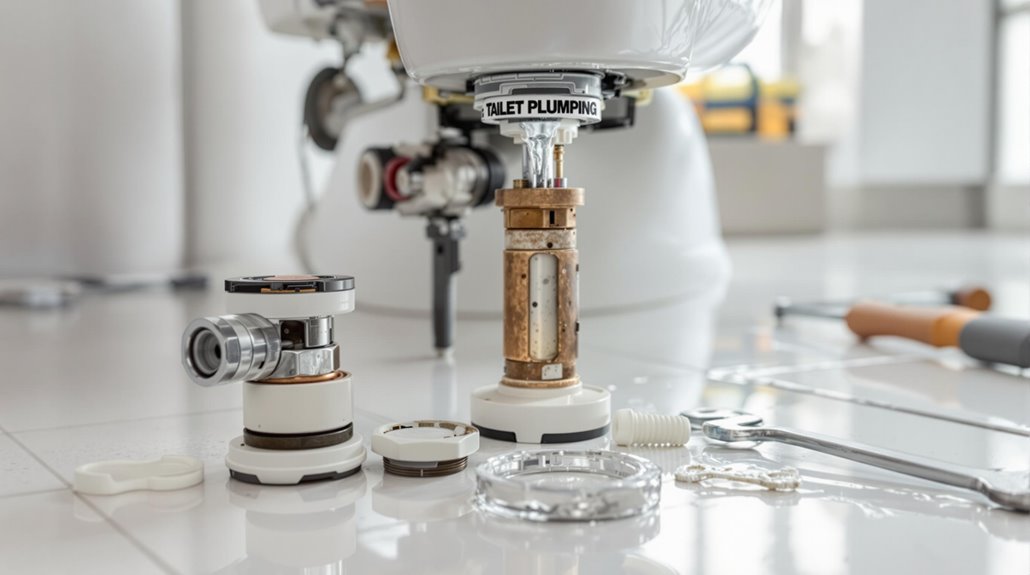
Toilet tank problems can disrupt your daily routine and lead to increased water bills if left unchecked. Common issues include:
- Faulty Toilet Flapper: A worn or misaligned flapper can cause constant running, wasting water.
- Tank Leaks: Cracks in the tank or loose connections may lead to leaks, requiring immediate attention.
- Water Level Issues: If the water level is too high or low, it can affect flushing efficiency.
- Clogged Fill Valve: Debris can block the fill valve, preventing the tank from filling properly.
Addressing these problems early can save you money and hassle. Regularly inspect your toilet and replace worn parts, like the toilet flapper, to maintain peak performance and prevent tank leaks.
Conclusion
Being prepared for plumbing emergencies can save you time, money, and stress. Imagine waking up to a burst pipe, only to find your emergency kit stocked with tools and supplies. When your toilet overflows unexpectedly, having a plan in place means you can tackle the issue swiftly. By staying informed about common plumbing problems like leaky faucets and water heater issues, you'll be ready to handle any situation that arises, ensuring your home stays dry and functional.
